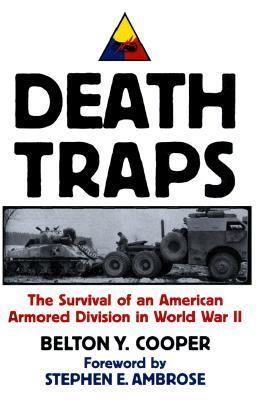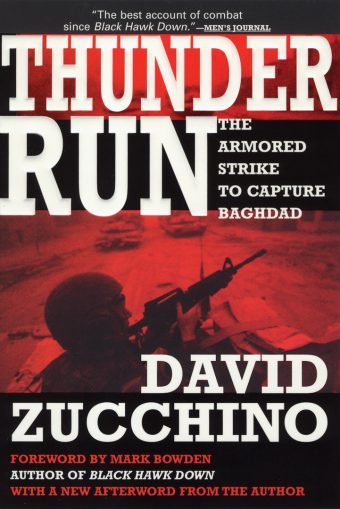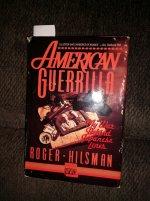It's pretty riveting stuff.I'll check it out. I work with a guy who was 1st recon and was there. Interesting to compare his experience vs the book and show.
Gamecock Fanatics
You are using an out of date browser. It may not display this or other websites correctly.
You should upgrade or use an alternative browser.
You should upgrade or use an alternative browser.
What book is on your nightstand right now?
- Thread starter Swayin
- Start date
You are headed in the right direction, but higher up the chain of command than Patton.I have always read that many sub commanders early in the war risked court martial by converting their magnetic detonators to contact detonators ... and that that much like Patton's weighing in in favor of continued use of the incredibly undergunned and underarmored Sherman instead of moving to the obvious upgrade of the Pershing, it was all driven by personalities.
In his book, Citizen Soldiers, Stephen Ambrose attributes the design of the Army that fought in WWII to then Army Chief of Staff, General George C. Marshall. Marshall desired faster, and therefore lighter, tanks in great numbers to be able to exploit a breakthrough rather than fight against other tanks. He did this with an anticipated war in Northwestern Europe in mind.
Overseas transportation was in short supply and you could put two Sherman tanks in an LST in the same space that you could only put one larger tank. Ambrose writes of superior Tiger tanks trying to create and exploit a breakthrough during a major counterattack to try to push the Allies back towards the sea only to have their crews abandon them after running out of fuel.
Lighter tanks also consume less fuel as well and our fast and bold attacks also took out the Germans' supply lines. So I guess you could say Marshall's strategy was correct in that sense.
I ordinarily prefer naval and aviation military histories, but Citizen Soldiers by Stephen Ambrose is another good read if you have the time.
Last edited by a moderator:
FurmanCock
Grand Poohbah
Pretty much anything by Stephen Ambrose is a good read.
Just finished a book about the battle of Spotsylvania (civil war). If you want to understand a civil war battle that was just ruthless and nasty, this is the one. Nothing romantic about hand to hand trench warfare in the rain. Desperation on both sides from Lee and Grant slugging it out. This may have been the ugliest battle of the civil war.
I’ve been to the field a few years ago and it’s really eerie being there knowing how much carnage there was in such a small area. The trenches still stand today.
I’ve been to the field a few years ago and it’s really eerie being there knowing how much carnage there was in such a small area. The trenches still stand today.
Black Hawk Down is one of the best books...of any genre...I've ever read.Great book, great miniseries. I also heartily recommend the book version of Blackhawk Down - won the Pulitzer.
I also highly...HIGHLY...recommend...Not A Good Day To Die: The Untold Story of Operation Anaconda by Sean Naylor...who was there. This one is unbelievable! One of...if not THE battle of post 9/11 Afghanistan and these guys got sent into the wood chipper with their dicks hanging out. You have got to read this one to fully understand what I am talking about, So much wrong along with so much bravery, sacrifice and fight. This is guys fighting for each other while their country played games and politics. This is a must read about a 'war' that is still going on as I type this.

Fiasco by Thomas Ricks is also a really good book from around this same time...but read Not A Good Day To Die first!
Last edited by a moderator:
Loved Citizen Soldiers. You are right about Marshall, but he was in lockstep with Patton, who as our premier armored theorist threw a lot of weight into the discussion - like Marshall he viewed faster tanks as modern cavalry and that was what was behind the design of the Chaffee, for example. But to truly understand the failure along these lines and how Patton pushed the Sherman in the face of horrifying loss numbers due to its incredible mediocrity, here's a really good read that will open your eyes:You are headed in the right direction, but higher up the chain of command than Patton.
In his book, Citizen Soldiers, Stephen Ambrose attributes the design of the Army that fought in WWII to then Army Chief of Staff, General George C. Marshall. Marshall desired faster, and therefore lighter, tanks in great numbers to be able to exploit a breakthrough rather than fight against other tanks. He did this with an anticipated war in Northwestern Europe in mind.
Overseas transportation was in short supply and you could put two Sherman tanks in an LST in the same space that you could only put one larger tank. Ambrose writes of superior Tiger tanks trying to create and exploit a breakthrough during a major counterattack to try to push the Allies back towards the sea only to have their crews abandon them after running out of fuel.
Lighter tanks also consume less fuel as well and our fast and bold attacks also took out the Germans' supply lines. So I guess you could say Marshall's strategy was correct in that sense.
I ordinarily prefer naval and aviation military histories, but Citizen Soldiers by Stephen Ambrose is another good read if you have the time.

The later model German tanks were so big and heavy that they often bogged down when off of the road as well as having numerous mechanical problems and fuel issues as mentioned.Loved Citizen Soldiers. You are right about Marshall, but he was in lockstep with Patton, who as our premier armored theorist threw a lot of weight into the discussion - like Marshall he viewed faster tanks as modern cavalry and that was what was behind the design of the Chaffee, for example. But to truly understand the failure along these lines and how Patton pushed the Sherman in the face of horrifying loss numbers due to its incredible mediocrity, here's a really good read that will open your eyes:

If tanks and armored infantry brigades are your cup of tea I also recommend Thunder Run by David Zucchino about the initial armored strike to capture Baghdad. Fast paced read about the initial three day push from outside the city to the Presidential Palace...another one where the author was along for the ride.


Last edited by a moderator:
Loved Citizen Soldiers. You are right about Marshall, but he was in lockstep with Patton, who as our premier armored theorist threw a lot of weight into the discussion - like Marshall he viewed faster tanks as modern cavalry and that was what was behind the design of the Chaffee, for example. But to truly understand the failure along these lines and how Patton pushed the Sherman in the face of horrifying loss numbers due to its incredible mediocrity, here's a really good read that will open your eyes:

You guys will like this video I stumbled upon last week of a rare King Tiger tank. Watch the engine start procedure.The later model German tanks were so big and heavy that they often bogged down when off of the road as well as having numerous mechanical problems and fuel issues as mentioned.
88 mm porno schlong for a gun barrel. Volkspanzer. LOL
Last edited by a moderator:
No doubt. Over-engineered in so many ways and prone to mishap, but of course deadly when up and running. Some great books are out there about the Battle of Prokhorovka - a sub-battle of the Kursk offensive, that was perhaps the greatest tank-on-tank conflict of the war, and the first action of the Ferdinand, among others. Ludicrously accurate and effective German gunnery and armor vs sheer hordes of T-34s.The later model German tanks were so big and heavy that they often bogged down when off of the road as well as having numerous mechanical problems and fuel issues as mentioned.
I met Andy Weir about three years ago when he came to an event at the university where I work - very nice, very approachable, very cool guy!I just finished The Martian by Andy Weir, The Beach by Alex Garland, and Artemis by Andy Weir. All three are excellent. I just started The Animal Factory by Edward Bunker.
FurmanCock
Grand Poohbah
I have The Martian and Project Hail Mary in my audible library waiting their turn. I just finished reading 8 volumes of The Expanse by James Corey, with volume 9 coming out later this year. For any SF fans, I highly recommend this series...by the way, it is also a TV series for Amazon Prime going into it's 6th season this year -- but has started deviating from the books.I just finished The Martian by Andy Weir, The Beach by Alex Garland, and Artemis by Andy Weir. All three are excellent. I just started The Animal Factory by Edward Bunker.
I would not even begin to know who the current popular authors are. I still think books are better for increasing mental sharpness as opposed to the undisciplined stream-of-consciousness flow of social media.I met Andy Weir about three years ago when he came to an event at the university where I work - very nice, very approachable, very cool guy!
However, I do find the web very useful for providing maps that are often missing in the military history books I like to read.
Currently reading 'Jason Molina; Riding With The Ghost' by Erin Osmon about the late great Jason Molina of Songs: Ohia and Magnolia Electric Co. Terrific so far. Wildly talented songwriter but seriously flawed and unable to cope...for those who may not know who Jason Molina was:
Im the same way. The book above caused me to have an atlas of the Mediterranean coats of Spain and France open for constant checking.I would not even begin to know who the current popular authors are. I still think books are better for increasing mental sharpness as opposed to the undisciplined stream-of-consciousness flow of social media.
However, I do find the web very useful for providing maps that are often missing in the military history books I like to read.
I met Andy Weir about three years ago when he came to an event at the university where I work - very nice, very approachable, very cool guy!
I haven't read Project Hail Mary yet, but it's in the queue for certain. I thoroughly enjoyed the two I already read. The movie version of The Martian follows the book pretty well, but there's a lot more science and fleshing out of the story in the book as is normally the case.I have The Martian and Project Hail Mary in my audible library waiting their turn. I just finished reading 8 volumes of The Expanse by James Corey, with volume 9 coming out later this year. For any SF fans, I highly recommend this series...by the way, it is also a TV series for Amazon Prime going into it's 6th season this year -- but has started deviating from the books.
I'm a little ways into The Animal Factory now, and I had that feeling that the story was familiar. Apparently I watched the movie version of it a while back. I didn't even realize that when I picked up that book. That was the way The Beach was for me too.
Last edited by a moderator:



